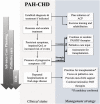Palliative care in pulmonary hypertension associated with congenital heart disease: systematic review and expert opinion
- PMID: 33660435
- PMCID: PMC8120400
- DOI: 10.1002/ehf2.13263
Palliative care in pulmonary hypertension associated with congenital heart disease: systematic review and expert opinion
Abstract
Aims: Pulmonary arterial hypertension (PAH) is common amongst patients with congenital heart disease (CHD). It is a severe and complex condition that adversely affects quality of life and prognosis. While quality of life questionnaires are routinely used in clinical pulmonary hypertension practice, little is known on how to interpret their results and manage PAH-CHD patients with evidence of impaired health-related quality of life, especially those with advanced disease and palliative care needs.
Methods and results: We performed a systematic review of studies concerning palliative care for people with PAH-CHD, also reviewing the health-related quality of life literature pertaining to these patients. Of 330 papers identified through initial screening, 17 were selected for inclusion. Underutilization of advance care planning and palliative care resources was common. Where palliative care input was sought, this was frequently late in the course of the disease. No studies provided evidence-based clinical criteria for triggering referral to palliative care, a framework for providing tailored care in this patient group, or how to manage the risk of sudden cardiac death and implantable cardioverter defibrillators in advanced PAH-CHD. We synthesize this information into eight important areas, including the impact of PAH-CHD on quality of life, barriers to and benefits of palliative care involvement, advance care planning discussions, and end-of-life care issues in this complex patient group, and provide expert consensus on best practice in this field.
Conclusions: This paper presents the results of a systematic review and expert statements on the preferred palliative care strategy for patients with PAH-CHD.
Keywords: Advance care planning; Congenital heart defects; End-of-life care; Palliative care; Pulmonary hypertension; Systematic review.
© 2021 The Authors. ESC Heart Failure published by John Wiley & Sons Ltd on behalf of European Society of Cardiology.
Conflict of interest statement
All authors have been consultants to and have received grant support and personal fees from Janssen‐Cilag Limited during the conduct of the study. Dr Condliffe has received personal fees from Bayer and GlaxoSmithKline. Dr Clift has received personal fees from Bayer. Professor Tulloh has received personal fees from Pfizer, Abbott International, GlaxoSmithKline, and Bayer. Professor Dimopoulos has received grants and personal fees from Pfizer, GlaxoSmithKline, and Bayer/MSD.
Figures



Similar articles
-
Pulmonary arterial hypertension in adults with congenital heart disease: markers of disease severity, management of advanced heart failure and transplantation.Expert Rev Cardiovasc Ther. 2021 Sep;19(9):837-855. doi: 10.1080/14779072.2021.1977124. Epub 2021 Sep 20. Expert Rev Cardiovasc Ther. 2021. PMID: 34511015 Review.
-
Management of Adults With Congenital Heart Disease and Pulmonary Arterial Hypertension in the UK: Survey of Current Practice, Unmet Needs and Expert Commentary.Heart Lung Circ. 2018 Aug;27(8):1018-1027. doi: 10.1016/j.hlc.2017.10.018. Epub 2017 Nov 13. Heart Lung Circ. 2018. PMID: 29191503
-
[Pulmonary arterial hypertension in patients with congenital heart disease: current issues and health care situation].Dtsch Med Wochenschr. 2013 Jun;138(23):1247-52. doi: 10.1055/s-0033-1343189. Epub 2013 May 29. Dtsch Med Wochenschr. 2013. PMID: 23720182 Review. German.
-
A review of the management of pulmonary arterial hypertension associated with congenital heart disease.Eur J Cardiovasc Nurs. 2012 Jun;11(2):239-47. doi: 10.1016/j.ejcnurse.2010.10.001. Epub 2012 Mar 5. Eur J Cardiovasc Nurs. 2012. PMID: 21093377 Review.
-
Pulmonary hypertension in children with congenital heart disease (PAH-CHD, PPHVD-CHD). Expert consensus statement on the diagnosis and treatment of paediatric pulmonary hypertension. The European Paediatric Pulmonary Vascular Disease Network, endorsed by ISHLT and DGPK.Heart. 2016 May;102 Suppl 2:ii42-8. doi: 10.1136/heartjnl-2015-308378. Heart. 2016. PMID: 27053697
Cited by
-
The PAH patient's perspective.Int J Cardiol Congenit Heart Dis. 2025 May 26;21:100596. doi: 10.1016/j.ijcchd.2025.100596. eCollection 2025 Sep. Int J Cardiol Congenit Heart Dis. 2025. PMID: 40546754 Free PMC article. Review.
-
An interdisciplinary consensus approach to pulmonary hypertension in developmental lung disease.Eur Respir J. 2024 Sep 26;64(3):2400639. doi: 10.1183/13993003.00639-2024. Print 2024 Sep. Eur Respir J. 2024. PMID: 39147412 Free PMC article. Review.
References
-
- Duffels MGJ, Engelfriet PM, Berger RMF, van Loon RLE, Hoendermis E, Vriend JWJ, van der Velde ET, Bresser P, Mulder BJM. Pulmonary arterial hypertension in congenital heart disease: an epidemiologic perspective from a Dutch registry. Int J Cardiol 2007; 120: 198–204. - PubMed
-
- Lowe BS, Therrien J, Ionescu‐Ittu R, Pilote L, Martucci G, Marelli AJ. Diagnosis of pulmonary hypertension in the congenital heart disease adult population impact on outcomes. J Am Coll Cardiol 2011; 58: 538–546. - PubMed
-
- Cha KS, Cho KI, Seo JS, Choi JH, Park YH, Yang DH, Hong GR, Kim DS. Effects of inhaled iloprost on exercise capacity, quality of life, and cardiac function in patients with pulmonary arterial hypertension secondary to congenital heart disease (the Eisenmenger syndrome) (from the EIGER Study). Am J Cardiol 2013; 112: 1834–1839. - PubMed
-
- Amedro P, Basquin A, Gressin V, Clerson P, Jais X, Thambo JB, Guerin P, Cohen S, Bonnet D. Health‐related quality of life of patients with pulmonary arterial hypertension associated with CHD: the multicentre cross‐sectional ACHILLE study. Cardiol Young 2016; 26: 1250–1259. - PubMed
Publication types
MeSH terms
LinkOut - more resources
Full Text Sources
Other Literature Sources
Medical

